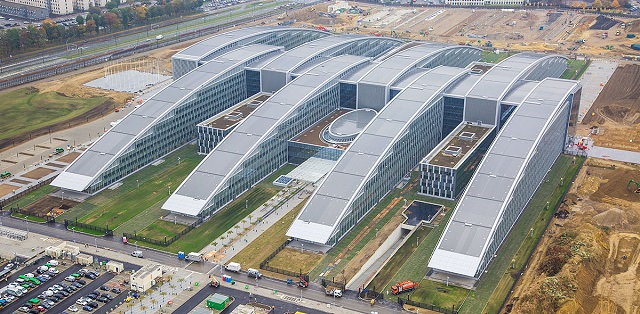
Brussels, Belgium | AFP | With its futuristic curved roof, gleaming walls of glass and steel and host of eco-friendly features, NATO’s new billion-euro Brussels headquarters is a world away from the drab, low-slung warren of offices reeking of Cold War intrigue that it replaces.
The alliance is almost halfway through its move into the new building, with Secretary General Jens Stoltenberg expected to shift to his new office at the end of the month and completion due in mid-June in time for July’s summit.
And while the old HQ has seen some of NATO’s most important moments — not least the United States’ invocation of the alliance’s mutual self-defence pact after the 9/11 attacks — few disagree the time has come for an upgrade.
Stoltenberg’s deputy Rose Gottemoller, the first woman to chair meetings of NATO’s governing North Atlantic Council, said a storm during the winter brought home the urgency of the move.
“As I was sitting at my desk I suddenly heard a drip drip drip behind me and there was a big leak in my office,” she told reporters.
“I was moving the printers and so forth around to make sure they didn’t electrocute me as I was sitting at my desk. It is high time to move.”
Next Friday’s meeting of NATO foreign ministers will be the 70th and last such gathering in the old headquarters, which was only meant to be a temporary fix after the alliance moved from Paris but has lasted half a century.
Since then the alliance has expanded from 15 to 29 members and the old building — originally built as a military hospital — has been unable to keep up, with portakabins thrown up in car parks to house extra office space.
– Cyber threat –
In the bowels of the building, a control room with banks of vintage switches and lights is still used to run the power system, with enormous generators that would look at home in the engine room of an oil tanker on standby in case of failure.
The 1.17-billion-euro ($1.37 billion) new HQ, which lies a short distance away across the busy Leopold III highway, has a rather more modern feel, with glass elevators noiselessly whisking staff up its seven floors.
NATO proudly trumpet the building’s green credentials — it is designed to use the sun’s energy efficiently to do away with the need for heating or air-conditioning and rainwater is harvested from the roof for use in toilets and the gardens.
The building, with 254,000 square metres of office space, is arranged around a cavernous central hall, a design intended to encourage the 4,000 staff to meet and mingle — a conscious move to break from the old place, where Cold War ghosts can almost be heard still whispering in the dingy corridors.
But a 21st century building comes with 21st century problems, and the new HQ was held up by the need to make sure the IT systems were secure enough to withstand the growing threat of cyber warfare — particularly as tensions with Russia are running high.
“Reliability and resilience in our IT systems are all important. We are bombarded daily by cyber attacks, by cyber incidents of all kinds. We must ensure the IT system is reliable and resilient,” Gottemoeller said.
 The Independent Uganda: You get the Truth we Pay the Price
The Independent Uganda: You get the Truth we Pay the Price


